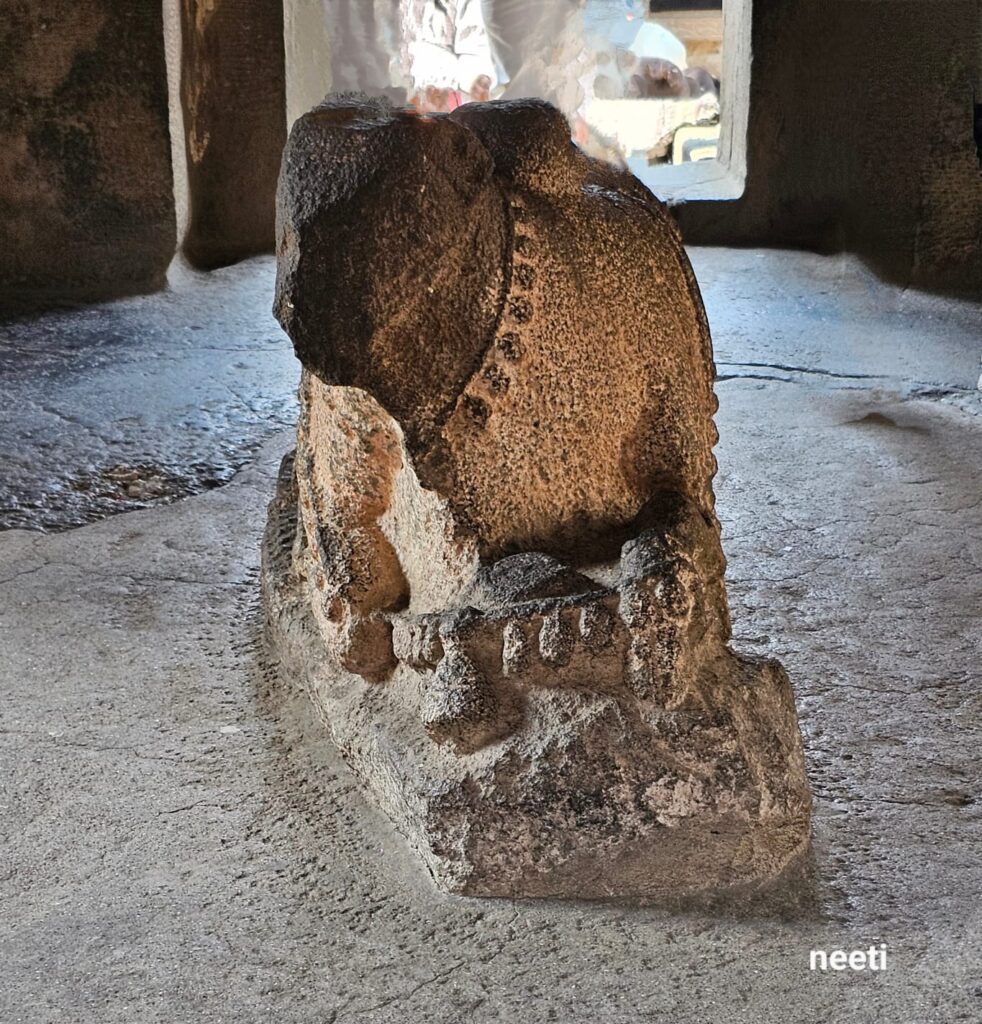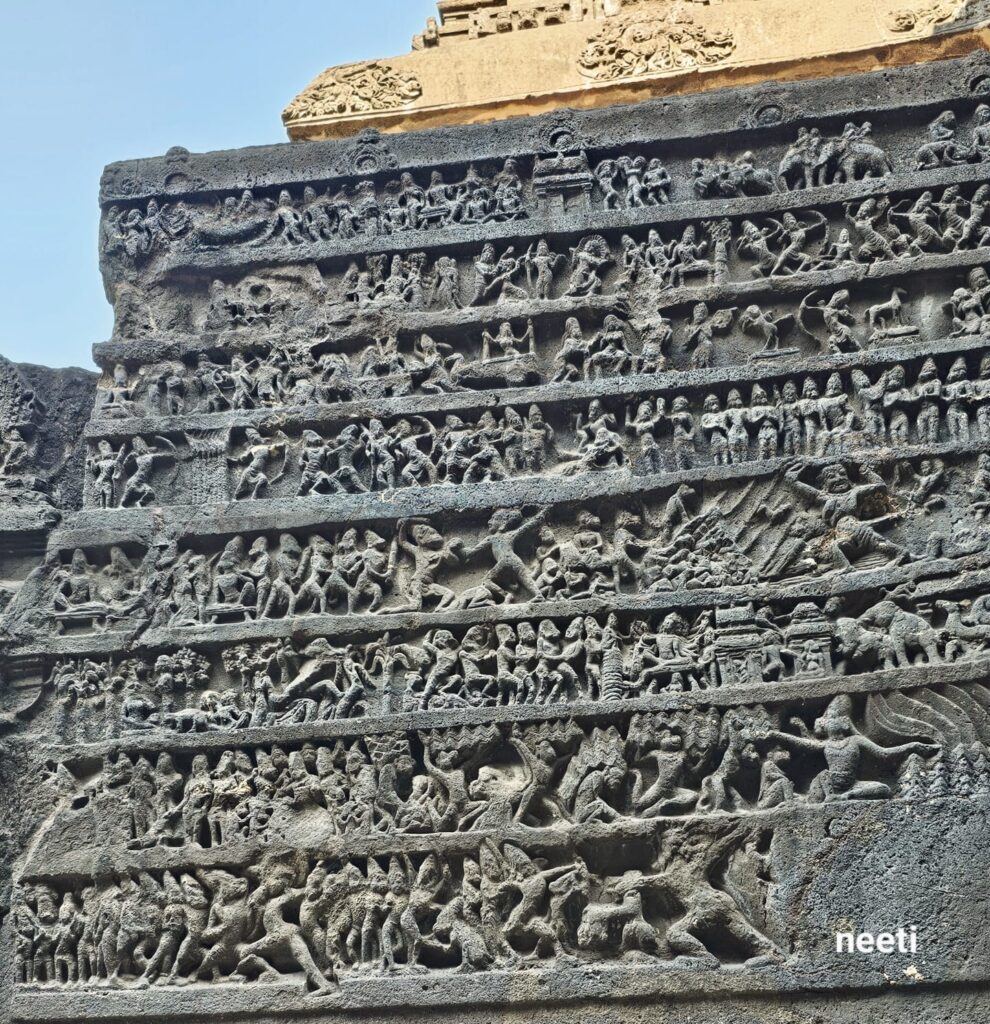
Introduction
The Ellora Caves, located in the Aurangabad District, Maharashtra are a UNESCO World Heritage Site with structures ranging from 600 to 1000 CE. Probably, the most well-known is the massive stone monolithic temple, the Kailasa temple. Monolithic temples are unique structures carved from a single rock.
The Kailasa temple, also known as the Kailashanatha temple, is a magnificent rock-cut Hindu temple located within the Ellora Caves complex. Carved out of a single cliff face, it is celebrated for its immense size, intricate architecture, and elaborate sculpture. The Temple is notable for its vertical excavation. Carvers started at the top of the original Basalt rock (Basalt is a very hard igneous rock formed from volcanic activity) and excavated downward.
The temple is the largest among the thirty-four cave temples and monasteries at Ellora, extending over two kilometres along the sloping basalt cliff. Its grandeur is exemplified by its towering structure, with the top of the sanctuary standing at 32.6 meters above the courtyard.
History and Architecture
The temple’s construction is attributed to the eighth-century Rashtrakuta king, Krishna I, who ruled from around 756 to 773 CE. However, some elements may have been completed in subsequent years. The architecture displays influences from the Pallava and Chalukya styles.
Splendour and Beauty
The temple is adorned with numerous relief and free-standing sculptures depicting various Hindu deities, mythological scenes, and celestial beings. The sculptures include the main shrine, its gateway, the nandi-mandapa, elephant-lion frieze, and victory pillars as well as the famous sculpture depicting Ravana shaking the Kailasa mountain.

Nandi Mandapa
At the entrance is Gajalakshmi sitting on the lotus with elephants pouring water on her from a pot. On the sides are sculptures for Shaivites and Vaishnavites.

Gajalakshmi
The main shrine houses the Shivalinga.
Found in the courtyard are giant elephant structures symbolising the strength of the Rashtrakuta kings. Inside are several sculptures and various panels, including the Mahabharata Panel and Ramayana Panel in seven rows, depicting scenes from Rama’s departure to the building of the bridge to Sri Lanka.

Ramayana Panel
Legends and Folklore
A medieval Marathi legend, preserved in texts such as Katha-Kalapataru by Krishna Yajnavalki (1470-1535 CE), appears to reference the construction of the Kailasa temple. According to this legend, a local king fell severely ill, prompting his queen to pray to the god Ghrishneshwar (Shiva) at Elapura for his recovery. She vowed to construct a temple if her wish were granted, and promised to fast until she could see the ‘shikhara’ (top) of the temple.
After the king’s recovery, she implored him to build a temple immediately. Despite architects’ claims that it would take months to complete a temple with a shikhara, one architect named Kokasa assured the king that the queen would see the shikhara within a week. Kokasa began constructing the temple from the top by carving into the rock, completing the shikhara within the promised timeframe. The temple was then named Manikeshwar after the queen.
The magnificent three-dimensional sculpture of Ravana Anugraha Murti on the southern side of the main temple is considered a significant feature that may have influenced the temple’s current name. In this sculpture, Ravana is depicted as multi-armed, attempting to lift Mount Kailash where Shiva is seated in repose. The ego of Ravana is depicted as being trampled by the mere pressure of Shiva’s toe, symbolizing the triumph of divine power over human arrogance. This portrayal of the mythological event could have contributed to the association of the temple with Mount Kailash and the name “Kailasa.”
The Amazing Reality
Though based on mythology, in reality, the temple was built from the top down. This extraordinary choice required the removal of 400,000 tons of volcanic rock. Historians agree that it was built in fewer than 18 years. This implies that in ancient days, 400,000 tons of hard rock were carved out using simple tools like hammers and cutters, and the temple was finished with gorgeous and detailed carvings in just 18 years.
To add to this amazing feat–no traces of rock debris have ever been found!
Neeti Parti
